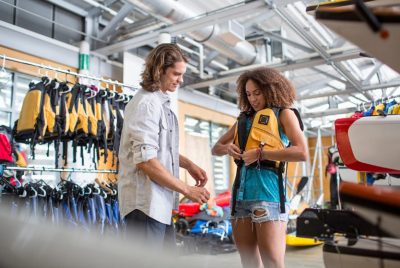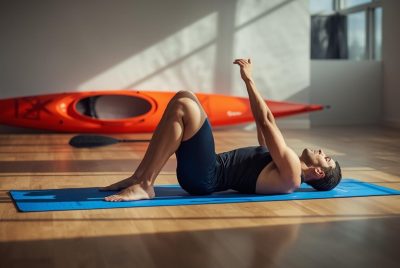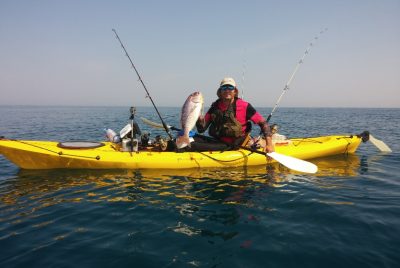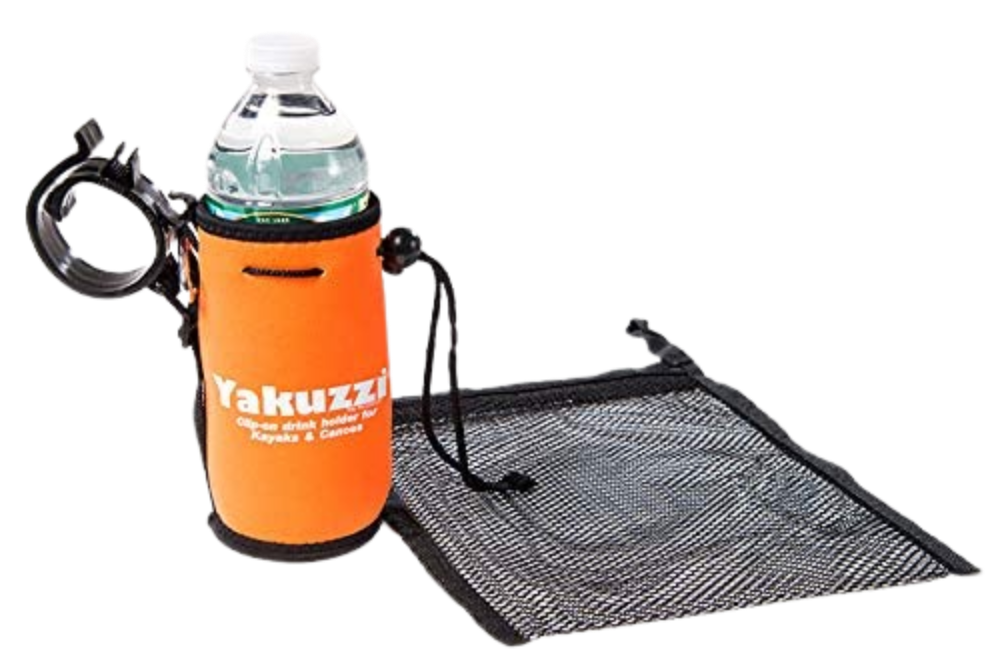Stepping into the world of kayaking is exciting, but it can also feel a little overwhelming—especially…
10 Game-Changing Kayak Fishing Gear Tips
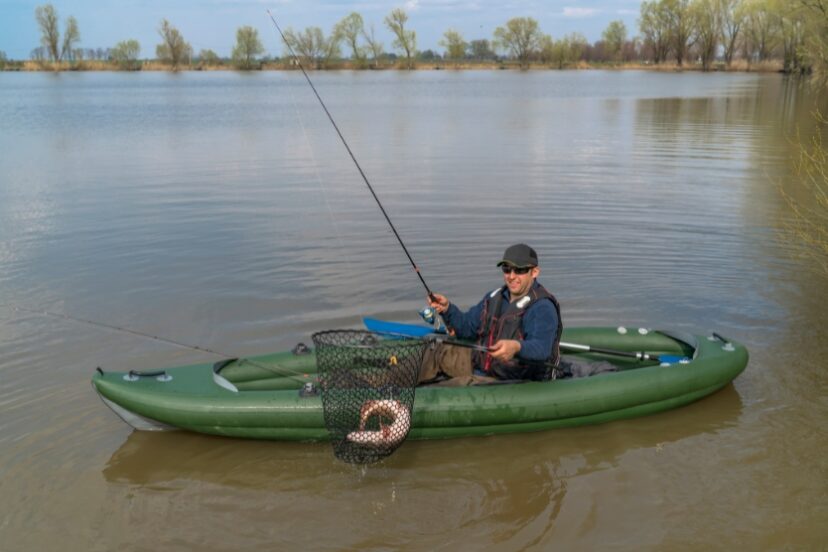
Kayak fishing unites the thrill of fishing with the adventure of kayaking, offering a unique experience on the water that’s both challenging and rewarding.
However, to maximize your time and increase your catches, having the right gear and knowledge is crucial.
Whether you’re navigating through tranquil lakes, coastal bays, or rushing rivers, the proper equipment can make all the difference.
In this article, we’ll explore 10 game-changing kayak fishing gear tips that will elevate your experience, improve your efficiency, and potentially increase your catch rate.
From essential gadgets to innovative accessories, these tips are designed to enhance your kayak fishing adventure, regardless of your skill level.
1)) Quality Paddle
Investing in a high-quality paddle is essential for efficient and comfortable kayaking.
Look for a paddle that is lightweight, durable, and adjustable to suit your paddling style and comfort level.
Tips for Choosing a Quality Paddle:
- Consider the Paddle Length: Your height and the width of your kayak will determine the ideal paddle length. Generally, taller individuals or those in wider kayaks will benefit from longer paddles.
- Select the Right Material: Paddles can be made from various materials, including fiberglass, carbon fiber, and aluminum. While fiberglass and carbon fiber are lightweight and efficient, aluminum paddles are more affordable but heavier.
- Look for an Adjustable Shaft: An adjustable paddle allows you to modify the length and blade angle, optimizing performance and comfort based on different conditions and personal preferences.
- Choose the Appropriate Blade Shape: Blades come in different shapes, such as wide and flat for power or narrow and long for speed. Consider your kayaking style and water conditions when selecting a blade shape.
- Opt for a Two-Piece Paddle: A two-piece paddle is easier to transport and store. It’s a practical choice for those who travel with their kayak.
- Test the Weight and Feel: Always check the paddle’s weight and grip comfort before purchasing. A lightweight paddle reduces fatigue during long fishing trips, enhancing your overall experience.
Selecting the right paddle is a fundamental step toward a more successful and enjoyable kayak fishing adventure.
By focusing on key factors such as length, material, adjustability, blade shape, and overall comfort, you can enhance your efficiency and stamina on the water.
The goal is to find a paddle that feels like an extension of your body—one that melds seamlessly with your paddling style and fishing needs.
2)) Fish Finder
A fish finder is a must-have tool for serious kayak anglers. This device uses sonar technology to locate fish underwater, helping you find the best fishing spots quickly and easily.
Tips for Choosing and Using a Fish Finder:
- Understand the Different Types: There are various types of fish finders, including standalone, combination (GPS/fish finder), and networked systems. Choose one that fits your fishing style and kayak setup.
- Consider Portability and Power Source: For kayak fishing, a portable fish finder is ideal. Look for one with a long battery life or a rechargeable battery.
- Check the Display Quality: A fish finder with a clear, high-resolution display will help you better identify fish, structures, and bottom contours.
- Select the Right Transducer: The transducer is the heart of the fish finder, sending and receiving sonar waves. Ensure it’s compatible with your fishing environment (freshwater or saltwater) and the depth you’ll typically fish.
- Learn About Frequencies: Fish finders operate on different frequencies. Higher frequencies (such as 200 kHz) are better for shallow water and finer detail, while lower frequencies (50-83 kHz) are suited for deeper waters.
- Opt for GPS Integration: A fish finder with built-in GPS not only helps you locate fish but also allows you to mark fishing spots and track your route on the water.
- Installation on a Kayak: Consider how the fish finder will be mounted on your kayak. Look for models that offer flexible mounting options that can easily adapt to your kayak’s design.
- Ease of Use: Choose a fish finder that is user-friendly, especially if you are new to using one. You want to spend more time fishing and less time figuring out how to operate your equipment.
Incorporating a fish finder into your kayak fishing arsenal is a game-changer that significantly enhances your ability to locate and catch fish.
By understanding the features and functionalities that best match your fishing and kayak setup, you can choose a device that maximizes your efficiency and effectiveness on the water.
Whether it’s through improved fish detection, navigation, or identifying promising fishing spots, a well-chosen fish finder can transform your fishing experience, making every trip more productive and enjoyable.
3)) Anchor System
An anchor system is crucial for staying in one spot while fishing, especially in windy or choppy conditions.
Look for an anchor system that is easy to deploy and retrieve, such as a stake-out pole or anchor trolley system.
Tips for Choosing and Using an Anchor System:
- Assess the Water Depth: Choose an anchor appropriate for the depth of the waters you’ll be fishing in. A lightweight anchor suffices for shallow waters, while deeper areas may require a heavier one.
- Select the Right Type of Anchor: Different types of anchors (grapnel, mushroom, stake-out pole, etc.) are suited to different seabeds (mud, sand, rock). Understand where you’ll be fishing most often to choose accordingly.
- Consider an Anchor Trolley System: An anchor trolley allows you to adjust the position of your anchor along the side of the kayak, giving you better control over your kayak’s orientation in the water.
- Portable Anchor Systems for Kayaks: Look for compact and lightweight systems that are easy to store within your kayak, particularly important for smaller kayaks with limited space.
- Quick Release Mechanism: Ensure your anchor system has a quick release mechanism or a way to easily detach it in case you need to move suddenly—important for safety.
- Ease of Deployment and Retrieval: Opt for an anchor system that is easy to deploy and retrieve from your kayak. This minimizes disruption and effort, allowing you to focus on fishing.
- Durability and Corrosion Resistance: Choose materials that resist corrosion, particularly if you’re fishing in saltwater. Stainless steel and galvanized metals are good choices.
- Secure Attachment Points: Make sure your kayak has secure points for attaching the anchor line, or consider installing them if necessary. Stability and safety are paramount when anchoring.
A well-integrated anchor system is essential for any kayak angler looking to maintain stability and precision in various fishing conditions.
By selecting the right anchor for your environment and employing a system that offers easy deployment, adjustability, and reliability, you can significantly enhance your fishing efficiency.
Whether battling wind, or current or simply wishing to stay in a prime fishing spot, a suitable anchor system ensures your kayak remains exactly where you need it to be, giving you the freedom to focus fully on the catch.
4)) Rod Holders
Rod holders are essential for keeping your rods secure while paddling or trolling. Choose rod holders that are durable, adjustable, and easy to install on your kayak.
Tips for Choosing and Using Rod Holders:
- Check Compatibility with Your Kayak: Ensure the rod holders you select can be securely attached to your kayak, whether through bolts, clamps, or suction mounts.
- Adjustability for Optimal Fishing: Look for rod holders that offer a range of adjustability, allowing you to angle your rod for trolling, bottom fishing, or storing your rod when not in use.
- Consider the Type of Fishing: Different types of fishing (trolling, spinning, fly fishing) might require different styles of rod holders. Choose accordingly to suit your most common fishing practices.
- Durability and Material: Opt for rod holders made from durable materials like high-grade plastics or corrosion-resistant metals, especially if you plan to fish in saltwater environments.
- Ease of Installation and Removal: Choose rod holders that are easy to install and remove, providing flexibility in positioning and the option to store them when not needed.
- Number of Rods: Consider how many rods you typically use simultaneously and select a system that can accommodate your needs, whether it’s a single holder or a multi-rod setup.
- Access and Safety: Ensure your rod holders do not obstruct your paddling or access to essential gear. Additionally, they should secure your rods safely to prevent loss overboard, especially in rough conditions.
Incorporating the right rod holders into your kayak fishing setup is more than just a convenience—it’s a strategic addition that enhances your angling efficiency and safety.
By selecting rod holders that meet your fishing style and kayak’s specifications, you ensure not only the security of your fishing rods but also ease of access and use.
This addition allows anglers to focus on the fishing experience, optimizing rod placement for any technique and condition, and ultimately contributing to a successful and enjoyable day on the water.
5)) Tackle Storage
Keeping your tackle organized and easily accessible is key to a successful day of fishing.
Invest in a tackle storage system that fits securely on your kayak and has plenty of compartments for organizing hooks, lures, and other gear.
Tips for Choosing and Using Tackle Storage:
- Prioritize Waterproof Options: Look for tackle boxes or bags that offer waterproof protection to keep your gear dry, especially important in the damp environment of kayak fishing.
- Select the Right Size: Choose a tackle storage solution that fits comfortably on your kayak without compromising its stability or your ability to move around.
- Organizational Features: Opt for storage options with multiple compartments or adjustable dividers, allowing you to organize your tackle by type, size, or method.
- Easy Access: Ensure your tackle storage is easily accessible from your seated position in the kayak. This reduces the need to move around and helps maintain stability.
- Durability: Select materials that can withstand exposure to water, sun, and general wear and tear. High-quality plastics, polycarbonate, or corrosion-resistant metals are excellent choices.
- Attachment Points: Look for tackle storage systems that can securely attach to your kayak, reducing the risk of losing your equipment in the event of capsizing or rough water.
- Portability: Consider tackle storage that is easy to carry to and from your launch point. Handles, straps, or lightweight designs can make transportation easier.
Effective tackle management is a crucial component of kayak fishing, directly influencing your ability to adapt and respond to changing conditions on the water.
The right tackle storage system not only protects your gear but also keeps it organized and within easy reach, allowing for more time fishing and less time searching for the right lure or tool.
By choosing a storage solution that balances size, accessibility, and durability, you ensure that your valuable tackle is secure and manageable throughout your fishing adventures, making every trip more productive and enjoyable.
6)) Personal Flotation Device (PFD)
Safety should always be a top priority when kayak fishing. Make sure to wear a comfortable and properly fitting PFD at all times while on the water.
Tips for Choosing and Using Personal Flotation Devices (PFDs):
- Prioritize Proper Fit: Ensure your PFD fits snugly yet comfortably, allowing full range of motion for paddling and fishing activities. Adjust the straps for a secure fit that doesn’t impede your movement.
- Check for USCG Approval: Choose a PFD that is approved by the United States Coast Guard (USCG) for optimal safety and reliability on the water.
- Select for Specific Use: Look for PFDs designed specifically for kayak fishing; these often include features such as pockets for gear, attachment points for tools, and a design that accommodates seated paddling.
- Visibility is Key: Opt for brightly colored PFDs or those with reflective materials to increase your visibility to other boaters, particularly in low-light conditions.
- Test It Out: Before heading out on the water, test your PFD in a controlled environment to ensure it keeps you afloat and you’re comfortable moving in it.
- Maintenance Checks: Regularly inspect your PFD for signs of wear and tear, such as rips, tears, or compromised buoyancy material, and replace it if necessary.
- Consider the Weather: In colder climates, look for PFDs that offer thermal protection, while in warmer areas, a PFD with good ventilation may be more suitable.
- Always Wear It: Most importantly, make a habit of wearing your PFD at all times while on the water, regardless of swimming ability or water conditions.
A Personal Flotation Device (PFD) is not just a safety requirement but a vital piece of fishing gear that can save lives.
Choosing the right PFD for kayak fishing ensures that you stay safe and comfortable while pursuing your passion.
It’s about more than compliance; it’s investing in your safety and peace of mind.
By prioritizing fit, functionality, and visibility, you ensure that your time on the water is not only enjoyable but secure.
The best PFD is the one you wear, so make it a non-negotiable part of your kayak fishing setup.
7)) Waterproof Storage
Protecting your valuables from water damage is essential when kayak fishing.
Invest in waterproof storage containers or bags to keep items such as cell phones, wallets, keys, and cameras safe and dry.
Tips for Choosing and Using Waterproof Storage:
- Assess Your Needs: Determine which items you need to protect from water and choose the appropriate size of waterproof storage accordingly.
- Verify Waterproof Rating: Look for products with a clear waterproof rating. IPX ratings provide a good indication of how well an item will withstand immersion.
- Opt for Durable Materials: High-quality, durable materials will ensure that your waterproof storage solutions stand up to the rigors of kayak fishing.
- Consider the Seal: A good waterproof container or bag will have a reliable sealing mechanism, such as a roll-top closure or a watertight zipper.
- Test Before Use: Before trusting a container or bag with your valuables, test its waterproof capabilities in a controlled environment.
- Use Floating Containers: If available, opt for storage that floats, which can help prevent the loss of valuables if they go overboard.
- Label Your Containers: Labeling your waterproof storage containers can help you quickly identify the contents, especially if you’re carrying several on your trip.
- Carry Backup Dry Bags: Having extra dry bags on hand can be a lifesaver for storing additional items or in case your primary storage fails.
Investing in reliable waterproof storage is essential for safeguarding your belongings against the unpredictable elements encountered during kayak fishing.
By choosing the right size, verifying the waterproof rating, and opting for durable materials with a secure seal, you ensure that your valuable items remain dry and protected.
Testing your waterproof storage before use and opting for floating options provide additional security and peace of mind.
With these precautions in place, you can focus on the fishing experience, knowing your essentials are safe from water damage.
8)) Landing Net
A landing net makes it easier to safely land fish without risking injury or losing them at the last minute.
Look for a lightweight yet sturdy net with a long handle for reaching into deeper water.
Tips for Choosing and Using a Landing Net:
- Select the Right Size: Choose a net that is large enough to safely land the types of fish you are targeting, but not so large it becomes cumbersome to handle.
- Rubberized Nets for Fish Safety: Opt for a net with a rubberized mesh to protect the fish’s slime coat, reducing harm and stress to the fish.
- Consider the Handle Length: A longer handle can help you reach further, which is especially useful from a kayak. Look for a telescoping handle for even greater versatility.
- Choose Durability Over Weight: While a lightweight net is easier to handle, ensuring it is durable enough to withstand the weight of your catch and the conditions of kayak fishing is crucial.
- Look for a Foldable Design: A net that folds or collapses can save valuable space in your kayak, making it easier to manage and store.
- Non-Slip Grip: Ensure the handle has a non-slip grip to enhance your handling, especially in wet conditions.
- Floatability: A floating net is a beneficial feature, preventing loss if it accidentally falls into the water.
- Easily Attachable: Look for a landing net that can be easily attached to your kayak or vest, so it’s always within reach when you need it.
A well-chosen landing net is an indispensable tool for any kayak angler, ensuring the safe and efficient landing of fish.
By selecting a net of the appropriate size, with features such as rubberized mesh for fish protection, a long or telescoping handle for reach, and a foldable design for easy storage, anglers can significantly improve their fishing experience.
Opting for durable materials and designs that offer convenience, such as non-slip grips and floatability, further enhances usability and ensures the net is a reliable part of your kayak fishing gear.
The right landing net not only helps in securing your catch but also contributes to the sustainability of our fishing practices by minimizing harm to the fish.
9)) Polarized Sunglasses
Polarized sunglasses not only protect your eyes from harmful UV rays but also help reduce glare off the water’s surface, allowing you to see fish more clearly underwater.
Tips for Choosing and Using Polarized Sunglasses:
- Check the UV Protection Level: Ensure the sunglasses offer 100% UV protection to safeguard your eyes from harmful ultraviolet rays.
- Polarization Quality: Not all polarized sunglasses are created equal. Look for high-quality polarization to effectively reduce glare and enhance underwater visibility.
- Fit and Comfort: Choose sunglasses that fit well and are comfortable for long periods, especially important when you’re out on the water all day.
- Lens Color: Different lens colors serve different purposes. For fishing, amber or brown lenses are great for enhancing contrast, while grey lenses are good for true color perception.
- Durability: Opt for sunglasses that are built to last, with scratch-resistant lenses and sturdy frames, to withstand the rough and tumble of fishing activities.
- Wraparound Design: A wraparound design provides better coverage and protection against sunlight entering from the sides.
- Floatability: Consider sunglasses that float, so you won’t lose them if they fall into the water.
- Adjustability: Features like adjustable nose pads and temples can help achieve a perfect fit, ensuring your sunglasses stay in place.
Choosing the right polarized sunglasses is crucial for any kayak angler, not only to protect the eyes from the sun’s harmful rays but also to enhance visual clarity and underwater visibility.
By prioritizing features like 100% UV protection, high-quality polarization, comfort, and durability, anglers can significantly improve their fishing experience.
Lens color selection plays a vital role in visibility under various lighting conditions, and additional features like wraparound design and floatability add to the functionality and safety of the sunglasses.
With the right pair of polarized sunglasses, anglers can enjoy a day on the water with clear vision, comfort, and protection, making every fishing trip more productive and enjoyable.
10)) First Aid Kit
Accidents can happen while out on the water, so it’s important to have a well-stocked first aid kit on board in case of emergencies.
Be sure to include essentials such as bandages, antiseptic wipes, pain relievers, and any necessary medications.
Tips for Choosing and Stocking a First Aid Kit:
- Essential Supplies: Ensure your kit includes bandages, antiseptic wipes, adhesive tape, scissors, tweezers, pain relievers, allergy medication, and waterproof sterile dressings.
- Waterproof Container: Store your first aid supplies in a waterproof container to keep them dry and ready for use, even in wet conditions.
- Personal Medications: Add any personal medications that you or your regular fishing companions may require in an emergency, including epinephrine pens or asthma inhalers.
- Sun Protection: Include sunscreen and lip balm with SPF to protect against sunburn and chapped lips.
- Insect Repellent: Pack insect repellent to prevent bites from mosquitoes and other insects common in fishing areas.
- Safety Tools: Add a small, waterproof flashlight and a whistle for emergencies where visibility is low or attracting attention is necessary.
- Knowledge is Power: Familiarize yourself with the basics of first aid and CPR. Consider taking a course if you haven’t already. Knowing how to use the items in your kit is as important as having them.
- Regular Checks: Regularly check your first aid kit for expired or depleted items and replace them as needed to ensure you’re always prepared.
- Easy Accessibility: Keep the first aid kit in an easily accessible location on your kayak or boat so that it can be quickly retrieved in an emergency.
Having a well-stocked and readily accessible first aid kit is a fundamental safety measure for any kayaking or fishing enthusiast.
By carefully selecting and maintaining essential items such as bandages, antiseptic wipes, personal medications, and safety tools within a waterproof container, anglers ensure they are prepared for various emergencies.
Equally important is the angler’s knowledge and ability to use these items effectively in stressful situations.
Regularly updating and familiarizing oneself with the first aid kit’s contents can make a significant difference in managing injuries or health issues promptly and efficiently, thereby enhancing safety and peace of mind during any aquatic adventure.
Conclusion
Properly equipping yourself with essential gear, from a reliable landing net to polarized sunglasses, and a well-stocked first aid kit, can significantly enhance your kayak fishing experience.
Each item on this list plays a vital role in not just ensuring a successful and enjoyable fishing trip but also in promoting safety and sustainability in the sport.
By prioritizing quality, comfort, and preparedness, kayak anglers can look forward to rewarding outings with peace of mind, knowing they are well-equipped to handle whatever challenges or opportunities the water may present.

